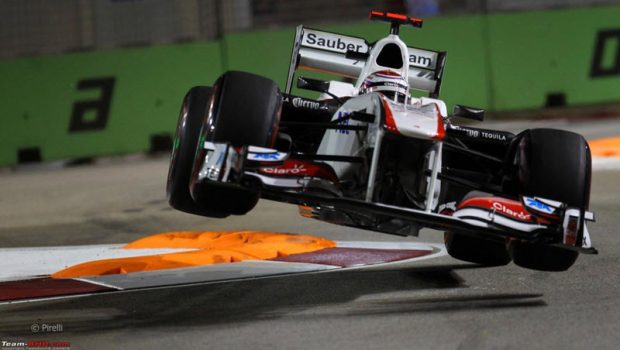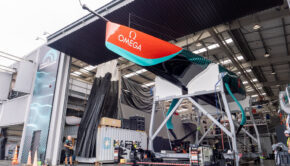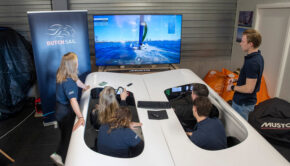Why this year’s America’s Cup is ‘F1 on Water’
Published on May 5th, 2017
During the 2013 America’s Cup, the goal was to appeal to the commoner. That was the San Francisco approach. But this America’s Cup has raised the stakes, as Tom Cary of The Telegraph reports…
Formula One and the America’s Cup. Both sports involve serious amounts of money, attract luxury brands, and frequently get bogged down in multimillion dollar lawsuits, usually over arcane rules. But the similarities between Formula One and the America’s Cup do not end there.
In fact, with the 35th Cup in Bermuda fast approaching – the qualifying series for the six competing teams kicks off at the end of May – the links between the two sports are becoming ever deeper, to the extent that the America’s Cup is now openly billing itself as ‘F1 on Water’.
It is easy to see why.
Yachting may sound like a comparatively genteel pastime when placed alongside the mad bad world of motorsport, but the days of sleek monohulls helmed by commodores in white trousers are long gone. The America’s Cup, as a sport, as a brand, is changing. Fast. And it is to motorsport’s premier category that it is looking for inspiration, both on and off the water.
On it, the name of the game is speed, pure and simple. It is about pushing the boundaries of what is possible from an engineering point of view. The machines which will be racing around Bermuda’s Great Sound next month are to sailing boats what F1 cars are to road going saloons. Basically, nothing like them.
These are not sailboats in the traditional sense. They are high-performance catamarans capable of ‘flying’ out of the water on hydrofoils in as little as 7 knots of breeze. And if the wind gets up, well, then they really shift. They are capable of travelling at around 45 knots (50 mph) in winds half that speed.
The boats themselves are controlled by hydraulic systems powered by sailors (the New Zealand team are using leg rather than arm power, which has caused a stir in the paddock) who resemble contestants at a Mr Universe contest; these are serious athletes.
And, of course, every bit of telemetry is fed back to the team’s HQs, wherever they may be around the world, to be pored over by data analysts.
In terms of personnel, too, there is increasing overlap. Given the fact that the boats spend so much time ‘flying’ out of the water – ideally the hulls will not actually touch the water once the race starts – it is only natural that America’s Cup teams look to secure not only the best boat builders but the best aeronautical engineers and aerodynamicists.
And where are they to be found? In Formula One of course.
Sir Ben Ainslie’s team Land Rover BAR have already brought in Richard Hopkirk, who used to be Lewis Hamilton’s race engineer at McLaren, not to mention former McLaren team principal Martin Whitmarsh as CEO. They also consulted Red Bull’s design guru Adrian Newey early in proceedings.
And why not? Computational Fluid Dynamics, Fluid Structure Interaction, wind tunnels, simulators… it is basically the same game. Right down to spending millions of pounds on composite materials which may or may not actually make the boat go any faster.
“There is some stuff that we’ll do which will save a few hundred grams on the boat, which will be worth a fraction of a tenth of a knot,” admits Hopkirk. “But if you can bank a lot of those…”
Marginal gains. Land Rover BAR’s budget for this cup cycle is around $100million – still nowhere near the level of Ferrari or Mercedes but getting up there.
Of course, all this new-fangled technology – the hydraulic systems, the Human Machine Interface, the emphasis on aerodynamics – has upset many sailing traditionalists.
In this, too, the America’s Cup is treading a similar path to modern-day Formula One, which has alienated much of its core constituency. The petrolheads who long for a return to roaring V10s and cannot stand all the gadgets and gizmos, and don’t give a stuff about the sport’s carbon footprint.
The America’s Cup faced a similar question. For all that J-Class boats are beautiful to look at, they do not make for great television. The 34th America’s Cup, which went down to the wire in San Francisco as Ainslie helped to mastermind a stunning comeback win for Oracle Team USA against Emirates Team New Zealand, offered a glimpse of a more exciting, and lucrative future.
It is one that Cup teams are keen to cash in on; fast, furious, packaged neatly for television. And unashamedly commercial.
“To me the America’s Cup is an absolutely fascinating business model,” enthuses Whitmarsh. “As we saw in the last edition in San Francisco, we have something now which is dramatically exciting on television. The real essence, the real driving force behind F1 was television…
“It just feels fresh. I think it’s the age where…some other sports are fairly tainted at the moment but we have a sport which doesn’t have that [doping] surrounding it. It’s a sport which is overtly green. And what we’re trying to do with this team is different.”
Whitmarsh points to the building of Land Rover BAR’s new state-of-the-art facility on the Camber in Portsmouth as a statement of intent, much as the Norman Foster-designed McLaren Technology Centre (MTC) in Woking was for McLaren.
“We’re not building for one campaign,” he says. “Traditionally the America’s Cup has been billionaire-based and one campaign at a time. We’re doing something different. The MTC was a very, very powerful statement of intent. It did a number of things. It convinced investors to get involved. It convinced engineers, drivers and staff. It drew people to it because it said: ‘This is a business that is here for the long haul, this is a palace of engineering’ What you have [at the Land Rover BAR base] is a sort of MTC on the sea.”
It wouldn’t be like F1, though, unless there was some controversy brewing in the background. And this year’s America’s Cup has that covered, too. Just when it seemed the teams were united on a way forward, and a new framework agreement was announced mapping out a biennial cup cycle, Emirates Team NZ refused to play ball.
If the Kiwis win in Bermuda, they have threatened to bring back monohulls and tear down the new world. Bernie Ecclestone would no doubt approve.
Background: The 35th American’s Cup has attracted six teams (5 challengers and 1 defender) that will compete in the new 15-meter AC Class, with a series of qualifiers beginning on May 26, 2017 that lead to the start of the America’s Cup Match on June 17, 2017. Complete schedule.









 We’ll keep your information safe.
We’ll keep your information safe.